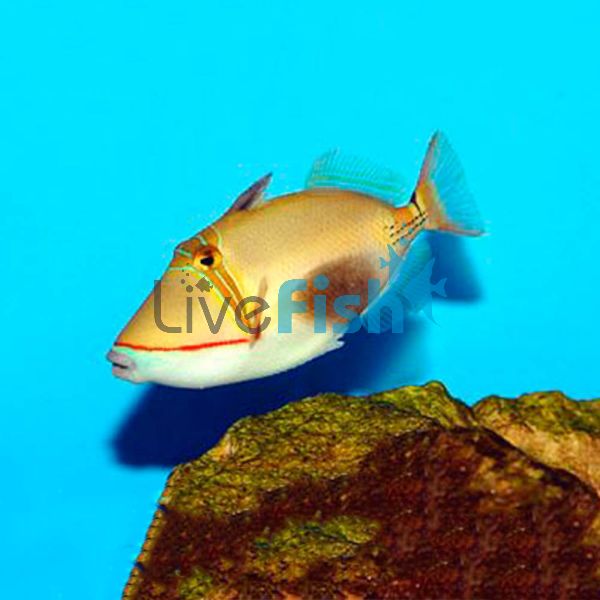Blackbelly Triggerfish - Medium
The Black Belly Triggerfish gets its name from the dark patch on its abdomen. Their body can be grey, tan, or a light brown to yellow color. A white color area runs from their chin across the lower body to the dark patch. A red or yellow line separates the white area from the rest of the body. A dark band with a blue outline runs down the side of their body, from the eye to the pectoral fins. It has three dorsal spines, the first can be raised and locked. This allows them to wedge themselves in rocks or crevices if they are attacked.
Triggerfish Blackbelly
The Black Belly Triggerfish gets its name from the dark patch on its abdomen. Their body can be grey, tan or a light brown to yellow colour. A white colour area runs from their chin across the lower body to the dark patch. A red or yellow line separates the white area from the rest of the body. A dark band with a blue outline runs down the side of their body, from the eye to the pectoral fins. It has three dorsal spines, the first can be raised and locked. This allows them to wedge themselves in rocks or crevices if they are attacked.
Males are larger than females of a similar age, so size is an immediate indicator of sex. The male's area will contain several female nests. Every three weeks, he will pair off with each of them for spawning. The female digs a hole in the substrate the day before spawning. She will deposit her eggs, then the male fertilizes them then guards them until they hatch.
The Black Belly Triggerfish is an Indo-Pacific species. They can be found in Indonesia, the Philippines, Japan, the Solomon Islands, and Vanuatu. Their natural environment is in lagoons or on reef flats, over rubble areas. Usually between depths of 1-20 metres.
Tank Recommendations for the Black Belly Triggerfish
Black Belly Triggerfish need a tank that is at least 125 gallons (473 litres) capacity
This species is not reef safe, as it will eat corals and invertebrates. It is best suited to a fish only tank, with live rock arranged as islands or groupings. There should be space and openings for it to swim through and cave or crevices for sleeping.
A sand substrate is recommended for them to blow into while hunting. There should also be plenty of seashells for them to turn over or bite onto. This helps wear down their teeth, which otherwise keep growing and make it difficult to eat.
Suitable Tank Buddies
The Black Bellied Triggerfish is an aggressive species. It can stay in a community tank as a juvenile but will start preying on other fish as it matures.
An aquarium with plenty of space and regular feeding may help to reduce aggression.
Usually Compatible
Large stinging anemones are one of the few things that are completely safe in a tank with this species.
Sometime Compatible
Large Angelfish, Pufferfish, Moray Eels, and Surgeons are considered more suitable companions. But these, and other large semi-aggressive fish will need monitoring. Groupers need to be added beforehand as juveniles when they aren't big enough to eat them. Triggerfish of a different genus such as the Pinktail, Niger, or Scythe may also be suitable.
Rarely Compatible
Avoid conspecifics and Triggerfish of the same genus. Small fish of any temperament are at risk, as well as slow movers such as Seahorses or Pipefish. This species of Triggerfish has a reputation for picking apart Lionfish. It will eat coral and consume invertebrates in the tank.
Feeding Your Black Belly Triggerfish
The Black Belly Triggerfish is an omnivore that will eat most things in an aquarium. They need a wide range of meaty food and marine vegetables. Shell food such a clams and hermit crabs will help wear their teeth down. Other suitable products include small fish, krill, and squid. Sinking pellets are good as they stop the Trigger from going to the surface for food and spitting water. Juveniles should be fed 4-5 times per day, adults 2-3 times per day.
| Scientific Name | Rhinecanthus Verrucosus |
|---|




